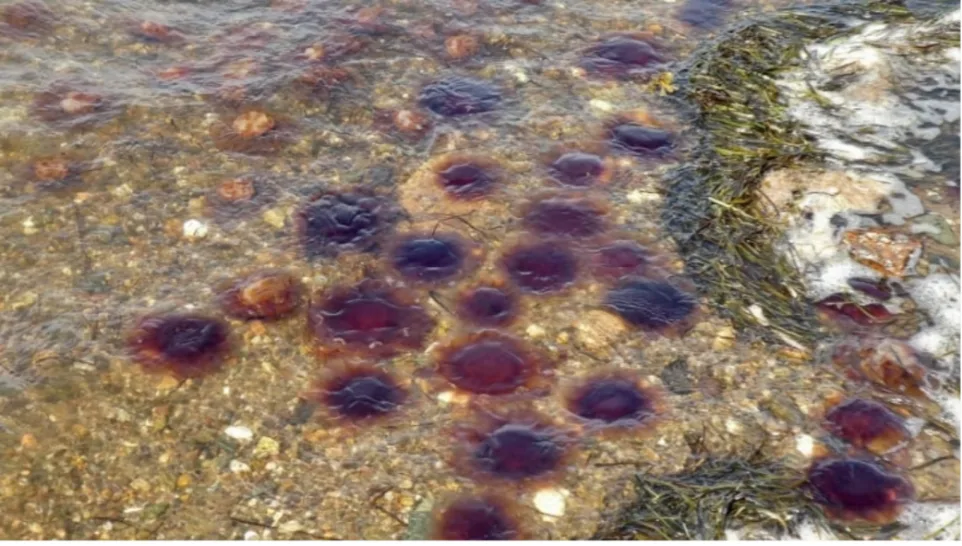
Hordes of 'gigantic' jellyfish keep beachgoers in Bathurst area alert
A large infestation of lion's mane jellyfish has drifted around Nepisiguit Bay since arriving earlier than usual this season.
"I've never seen so many above-average lion's mane jellyfish here," said Sabine Bittner, who has spent time in the Youghall Beach area of Bathurst just about every summer since the late 1980s and now lives there year-round.
"It's unbelievable."
In summer months, Bittner usually swims about a 45-minute loop just inside the mouth of the harbour. This season, she said, it's been more like "figure eights" as she tries to evade dozens of jellyfish.
"My head is tilting left and right all the time," she said, with a laugh.

Lion's mane jellyfish are washing up on the shoreline in the Bathurst area. (Submitted to CBC News by Sabine Bittner)
ARRIVED EARLIER THAN USUAL
Bittner doesn't let the jellyfish spoil her enjoyment of the water, but she is cautious to avoid coming into contact with their tentacles, which shoot barbs containing venom.
"You'll live through it," said Bittner, "but it stings pretty bad."
Lion's mane jellyfish are regular visitors to Nepisiguit Bay, but this summer has been unusual on three counts, said Bittner. They arrived four to six weeks earlier than usual. There have been a lot more of them than usual. And many have been much larger than usual.
The first day she was out swimming, during a heat wave in June, Bittner caught sight of a large jellyfish swimming next to her.
"When you see them for the first time it's always a bit of a shock."
"Usually, we never see them before the end of July," she said.
Even more startling, the jellyfish was about 60 centimetres in diameter — double the size normally seen in the area —and had tentacles about 3.6 metres long.
"By far the biggest I've ever seen," Bittner recounted.
"I'm fairly tall — five-eleven — and I sort of lined myself up next to it and the stingers were easily twice as long as I was."
She looked in the opposite direction and saw another jellyfish.
"I found myself all of a sudden between this monster and another the normal size, I'd say half of that."
And there were many more, she said.
Normally, Bittner only sees a handful all season that have drifted past the beach dunes and through the narrow channel into the harbour.
This year she's seen as many as 40 a day.
And several have been as large as the first.

Lion's mane jellyfish tentacles shoot a barb that contains venom, which can sting even if the jellyfish is dead. The barbs cannot penetrate palms of human hands or soles of feet though, and they are fragile enough to be removed by rubbing sand on the skin. (Submitted to CBC News by Sabine Bittner)
Jellyfish researcher Nick Record of the Bigelow Laboratory for Ocean Sciences in Maine said he's received reports of dense aggregations of lion's mane jellyfish from other parts of Atlantic Canada and from New England as well.
And about 10 jellyfish spotted have been close to 1.8 metres in diameter.
"This year there are gigantic jellyfish," said Record.
"To me it seems like there's something happening that's widespread."
Record has been studying jellyfish for about seven years.
He's not prepared to say there's a definite upward trend in population numbers or size.
It could be part of the "natural ups and downs" of the species, he said.
Those "ups" have included a huge outbreak of white cross jellyfish about 100 years ago. This was documented by oceanographer Henry Bigelow, for whom the Bigelow Laboratory is named.
OUTBREAKS 30 YEARS AGO
Another year there was a long period of jellyfish, said Record, which coincided with large numbers of mola molas, or ocean sunfish, which eat them.
And some of the public reports that have come into him compared this year to similar outbreaks 30 or more years ago.
Bittner and others are wondering whether warmer water is linked to the increased number of jellyfish they are seeing.
Record said temperatures could be "part of the story," because they influence the timing of food availability and growth rates, but he doesn't think they are "the heart of the explanation."
The lion's mane jellyfish is actually a cold-water species. It's known to grow up to two metres in diameter in Arctic waters.
It's possible, said Record, that the jellyfish numbers and sizes aren't different at all this year, but ocean currents have caused abnormally large clumps of them.
There are some places in the world's oceans where jellyfish have "taken over," however.
Record said that's been linked to overfishing and overdevelopment on the coast.
Docks or sea beds that have been trawled bare provide surfaces on which jellyfish polyps can get a better hold and flourish. And fewer fish mean less competition for food.
Runoff from agriculture and other development activities adds nutrients to the water that cause jellyfish food like phytoplankton to grow.
Meanwhile, all that organic matter is food for bacteria, which consume oxygen while they break it down, to the point that there isn't enough oxygen in the water for many fish to survive.
Jellyfish, however, do relatively well in low-oxygen water.
In that sense, they can be a good thing, said Record, for an ocean environment that's under stress.
"People think of them as a nuisance, but they do serve positive roles in the ecosystem as well."
Besides sunfish, sea turtles also feed on jellyfish.
FROM THE ARCHIVE: PEANUT BUTTER AND JELLYFISH? HERE'S WHY CANADA WON'T SHARE
RESEARCHER WELCOMES REPORTS
Record said he likes hearing about how jellyfish are affecting human activities as well.
His research depends on public reports. He urged people to email their jellyfish comments or photos to him at jellyfish@bigelow.org or to fill out a form on the laboratory website, jellyfish.bigelow.org.
He receives "hundreds and hundreds" of reports per year. He even publishes a jellyfish forecast, that he said he might expand north of Nova Scotia if more people in New Brunswick send him their sightings.
He plans to keep collecting data and once the season is over will start digging into possible causes of what seems to be a "really unusual" year.
WATCH BELOW: A GIANT HUMAN-SIZED JELLYFISH RECORDED IN RARE MOMENT
--
This article, written by Jennifer Sweet, was originally published for CBC News.









